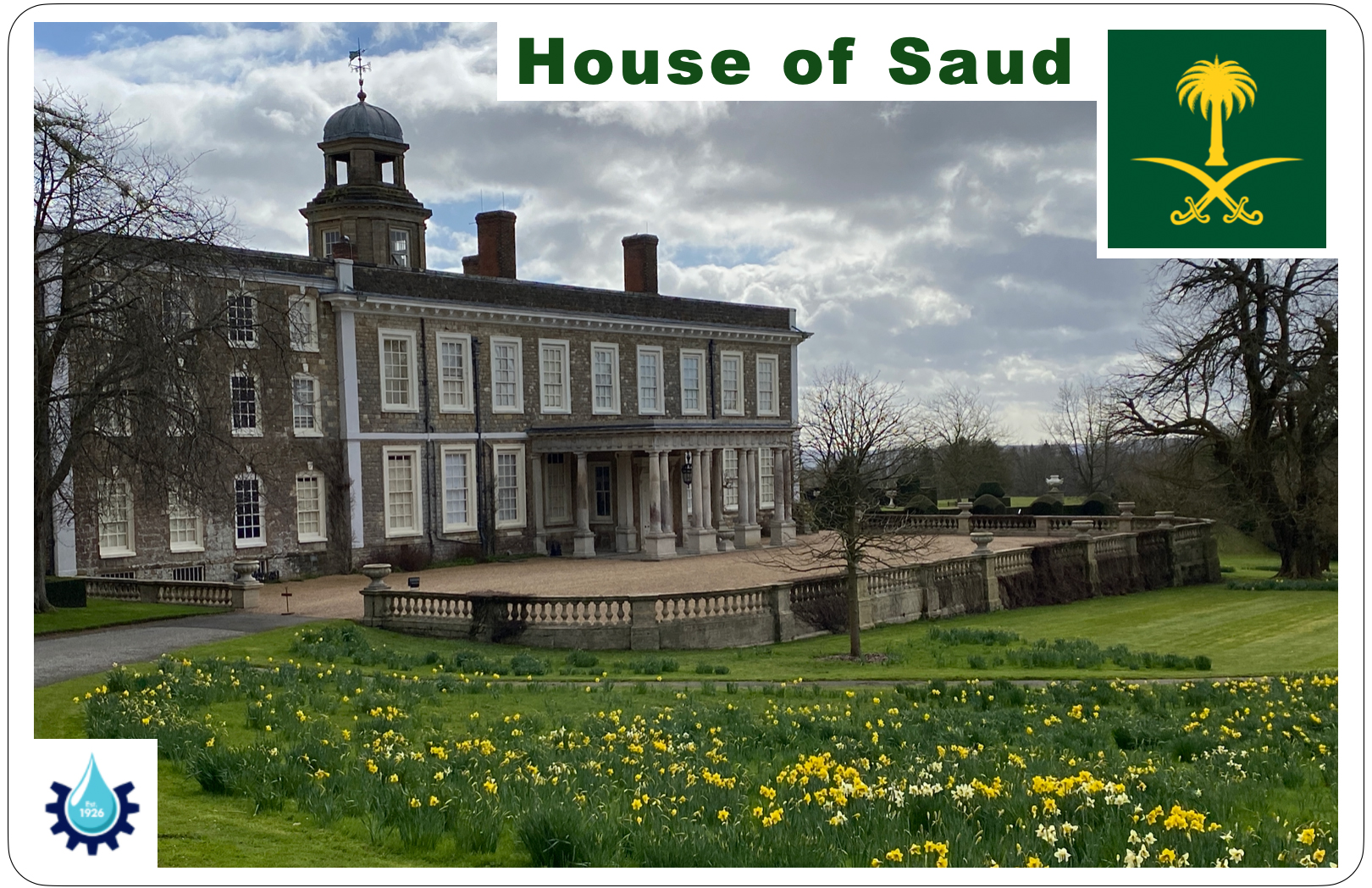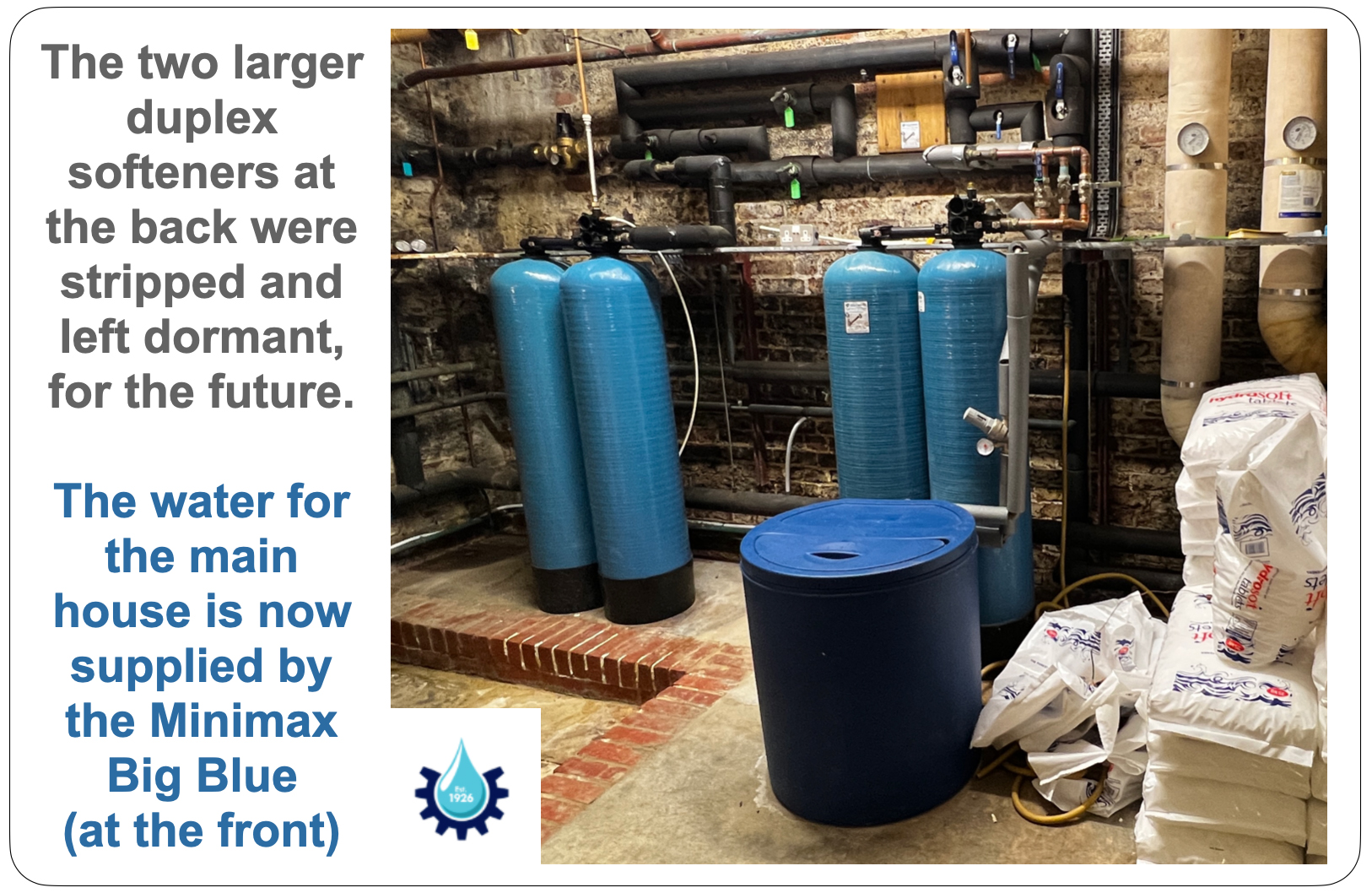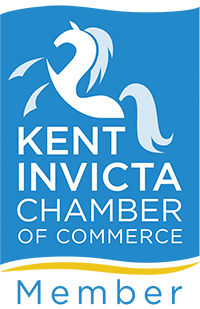Case Study – An Extensive Royal Country Estate in Kent
A Little Overview
Tucked away in the heart of the countryside, Fairlawne is an extensive estate owned by the ruling royal family of Saudi Arabia — the "House of Al Saud". It’s a place steeped in fascinating history, including some rather special ties to our own Royal Family, particularly the Queen Mother. (You can read more about that at the bottom of this page.)
At the heart of the estate sits a breathtakingly beautiful, Grade I listed stately home, surrounded by immaculately manicured gardens that look like something straight out of a classic English novel.
Once a lively retreat for the family, the main house has seen less and less use over the past 15 years, standing a little quieter these days but still every bit as grand.

Long before I bought Hydroworks, the estate upgraded their original water softeners, replacing them with two newer like-for-like models.
Unfortunately, a common mistake in our industry is to simply replace old systems without checking whether the property’s water usage has changed — and that’s exactly what happened here. Water usage can shift dramatically over time, and if the softeners aren’t correctly sized for the current needs, it can cause all sorts of expensive headaches.
Sadly, Fairlawne’s setup was no exception. Despite our best efforts — including making the softeners regenerate every four days — the estate was still battling hard water throughout. We could have pushed it to regenerate every other day, but even at four-day intervals, the running costs were already becoming a real cause for concern.
The Original Setup at Fairlawne
Tucked away in the basement of the main house were two hefty 9100 Duplex 75L water softeners. These fed into a cold water storage tank so large it could have easily passed for a small swimming pool! The tanks were topped up via three oversized, old-school copper ball valves — the kind you often see on loft tank systems - except much larger, but with all the same flaws.
(ADD PHOTO OF TANKS)
When I first took over Hydroworks, one of my early visits was to Fairlawne. It quickly became clear that something wasn’t quite right — the softeners were delivering hard water to the property.
At that point, the right first step was simply to service the equipment and make sure everything was running as it should, giving me time to develop the relationship with the on-site team and evaluate what was going on.
Over the months that followed, I made a point of popping back regularly to check the softeners’ performance. Each time, the story was the same: water hardness levels that were almost back to square one.
Since I was new to the estate, I was careful not to rush in with big recommendations — especially not ones that could be mistaken for ‘profit-chasing.’ I wanted to make sure that when I gave them my advice, it was based on proper groundwork, real-world experience, and a true understanding of the site’s needs.
And once I was confident in my assessment, I sat down with the Estate Manager to explain what I had found.
In short: the existing softeners were significantly oversized for the house’s current water usage.
I recommended replacing them with something smaller and more efficient. But I’d also picked up on something else — what we call trickle flow.
(Trickle flow happens when water is used so slowly that it meanders through the softener’s resin bed instead of flowing through it properly. Over time, a little channel forms, filling with chalky deposits. At first, you get soft water — but soon after, hardness creeps back in because the resin bed isn’t being used effectively. And to make matters worse, at very low flow rates, the meters often struggle to register the water passing through.)
Because of this, I suggested a two-pronged approach.
First, swap out the traditional ball valves for low-flow Keraflow valves. These clever devices let the water level drop much lower before refilling the tanks with a strong, fast gush — avoiding the slow dribble that causes so many softening issues.
At the same time, I recommended taking one of the two softeners offline to better match the house’s real water demand.
Reducing the stored water levels was also important — not just for water quality, but to minimise the risk of stagnation and bacterial growth.
I also proposed cleaning the tanks at the same time, while everything was accessible — and the Estate Manager agreed it was a good idea.
When he asked me whether this plan would solve the problem, I explained honestly:
“It’ll help to improve the water quality, but it probably won’t solve the hardness issue — because even with one softener offline, the remaining system is still a bit too big for the estate’s current needs.”
There was a thoughtful silence while he weighed up the options.
In the end, he gave me the green light to move ahead.
One concern he did raise was the cost sunk into the current softeners — understandably, he didn’t want to just throw them away. So I suggested a solution: I would dismantle (“put to sleep”) one or both softeners carefully, so that if the estate became busier again in the future, they could be easily reassembled and brought back into service.
This struck the perfect balance, and we agreed to proceed — with me keeping him updated at every step.
Let the Upgrades Begin
With a plan in place, we got to work. First up: replacing those three oversized, traditional ball valves in the tank with modern delayed-action Keraflow valves.
While we waited for the new valves to arrive, the estate team drained the tanks, cleaned them thoroughly, and refilled them with just enough water to cover the outlets. I wanted to keep the levels low and let the new valves do the work of managing it properly going forward.
Once fitted, the difference was immediate. We reduced the tank’s water height from nearly a metre down to just 45cm. Now, when the tanks refill, the water comes in at a proper rush — no more slow dribbles — helping the softener operate far more effectively. And if the estate gets busier in the future, the water level can be easily raised again to suit.

On that same visit, I stripped down one of the softeners, gave it a thorough clean (including the salt cabinet), and then gently “put it to sleep” — ready to be reawakened when needed.
This change alone meant an instant reduction in salt and water usage: a saving of 12.5kg of salt and over 325 litres of water per regeneration every four days. A BIG financial win for the estate.
That left just one of the original duplex softeners running.
At first, I left it with no override settings to see whether the changes we’d made — lower water levels, improved flow — had helped. But despite multiple visits over the next three months, the water was still coming through hard every time. Gradually, I began introducing the day-override, asking the softener to regenerate more frequently. But once we were down to every four days, it became clear: we’d reached the limit of what this system could do. Anything less and the running costs would be eye-watering!
So, I went back to see the Estate Manager.
I explained that while I could continue tweaking the settings, the cost of regenerating more often — in both salt and water wastage — was no longer justifiable. The best solution now was to replace the softener altogether.
To his credit, the Estate Manager fully agreed.
He thanked me for taking the time to thoroughly test each stage before pushing ahead — it gave him real peace of mind knowing that every decision was based on evidence, not guesswork. He said it felt good to know that the choice to upgrade had been properly earned.
The New Minimax Big Blue Water Softener is Installed
The first thing we did was to strip down and “put to sleep” the second original softener, just like the first. Then we installed the brand new Minimax Big Blue — positioning it neatly in front of the other two, ready to take on the job properly.
As we were finishing up, I noticed a full pallet of salt had just been delivered. The estate had been using up a whole pallet every month — costing them over £500 a month — thanks to the inefficiency of the old setup.
I smiled to myself, knowing they were about to be in for a rather nice surprise.
Two weeks later, I returned to test the water.
The difference was immediate:
– We dropped from 18 drops of hardness (308 ppm)
– To just 4 drops (69 ppm), and the signs that it was still going to get softer still!
The Estate Manager was absolutely delighted.
He told me the house staff were overwhelmed by the difference — dishes, glassware, showers, everything was noticeably better.
I promised him that we could get it even lower, right down into the completely soft category (0–17 ppm). I think he was a little sceptical at first — but the results were already speaking for themselves.
Interestingly, the team at the estate were initially a bit confused.
How was the softener working so well… when it didn’t seem to be using any salt?
That’s the magic of the Minimax Big Blue: massive power, impressive flow rates, guaranteed soft water — and crucially, very little salt usage.
(And just to prove the point: a year later, they are still using salt from that original pallet. Their savings have been absolutely colossal!)

The Savings Story
The results of the upgrades weren’t just about better water quality — the financial savings for the estate have been nothing short of extraordinary.
The Original Softeners
Originally, Fairlawne had two 75L Duplex 9100 softeners running in parallel, side by side.
Each month, the estate was burning through a staggering 49 bags of 25kg salt — costing them over £500 a month. Add in annual servicing costs for both machines, and their yearly salt bill alone was topping £6,000.
In terms of water usage, the regeneration process pulled approximately 60,000 litres of water every year! (While the estate’s own borehole meant the water itself was “free”, it still represented a major environmental cost — and potential maintenance risk — with that much water cycling through the system.)
Every time a regeneration cycle happened:
– 12.5 kg of salt was used
– 325 litres of water went into the process
Multiply that out across two oversized softeners, and it’s easy to see how the costs and inefficiencies added up so quickly.
The New Minimax Big Blue Water Softener
By switching to the Minimax Big Blue, the savings have been truly transformational:
– Only 900g of salt used per regeneration
– Just 50 litres of water used per regeneration
That’s a huge reduction compared to the old system — not just saving several thousands of pounds a year, but also dramatically cutting down water usage and environmental impact.
Best of all, the water throughout the main house is now completely softened at 0 PPM of hardness — achieving the perfect balance of performance, sustainability, and cost-efficiency.
A year on, the estate still hasn’t finished the pallet of salt they had delivered before the changeover — a wonderful reminder of just how far they’ve come.
(ADD NEW IMAGE OF RUNNING COSTS)
A British Royal Connection
JUBILEE MEMORIES OF ROYAL CONNECTIONS WITH FAIRLAWNE AND SHIPBOURNE By Sir Edward Cazalet
"In this Diamond Jubilee year of Queen Elizabeth II, our beloved Sovereign, I have been asked to write something about the Royal Family’s connections with Fairlawne and Shipbourne over the years.
It was back in 1871 that my grandfather, Edward, my namesake, bought Fairlawne and its estate. He was what was known as a “merchant squire”, that is to say someone who has left home to seek his fortune overseas and who, having been successful, has returned to his home country to buy a large house and estate for his retirement. In the 1870s, Edward had also bought a fine holiday villa in the South of France at Cimiez behind Nice, known as the Villa Liserb. This he did despite the fact that nearly two centuries previously his ancestors had fled from France to avoid persecution as committed Protestants.
It so happened that after William, his son, had inherited the estate and the Villa Liserb on Edward’s death, Queen Victoria used to come to stay at the villa adjoining the Cazalet’s villa. On these royal visits to the South of France for her summer holidays Queen Victoria loved to drive single handedly a small cart drawn by a donkey round the garden, even though driving space in the garden of the villa where she stayed was limited. The Cazalets, naturally, arranged for the Queen to be able to drive her cart in the larger garden of their villa.
As a result Queen Victoria and Mollie, William’s wife, soon became good friends and, consequent on this, Queen Victoria generously consented to becoming my Uncle Victor’s godmother at his christening on 27th December 1896. One of the family’s treasured possessions is a photograph, taken shortly before the Queen’s death, of her driving her donkey cart round the Villa Liserb garden, with the future Queen Ena of Spain, then a small girl, sitting in the cart with her.
Then, many years later, when both were at the school age of 13, my Aunt Thelma, my father’s elder sister who was brought up at Fairlawne, became a firm friend of Lady Elizabeth Bowes-Lyon, our future Queen Mother. This was to be a lifelong friendship and there is a lovely picture of the two of them, taken in 1912, sitting on a balustrade at Fairlawne. On the numerous visits which Lady Elizabeth as a young girl paid to Fairlawne, she regularly attended St Giles Church. This was, of course, before the First World War. After Aunt Thelma’s eldest brother, Edward, had been killed in the First World War (his small wooden cross, which was on his grave near the Somme where he was killed, can be seen to the left of the pulpit) and her second eldest brother, Victor had been killed in the Second World War, my father Peter Cazalet, the youngest of the Cazalet children, having survived the war, had already become well installed at Fairlawne.
There then came the big moment in 1949. By this time my father, assisted by his great friend Anthony Mildmay, had established, post war, an extremely successful steeplechasing stable at Fairlawne. In that very year the decision was taken that Princess Elizabeth, as our Sovereign then was, and her mother, then Queen Elizabeth, should share the ownership of a steeplechaser. My father, Peter, then had the honour of being asked to find and train a suitable steeplechaser for this august partnership. Of course, he leapt at it, and, as a result, the King, Queen and Princess Elizabeth, as she then was, visited Fairlawne to confirm the arrangement.
Following the death of King George VI in 1952, the present Queen, at a later stage, took on ownership of the National Stud flat-race horses. The Queen Mother then took over ownership of the steeplechasers. As a result, and for more than 20 years thereafter, my father trained the Queen Mother’s steeplechasers at Fairlawne and won no less than 250 races for her as an owner. In a highly competitive field this was no mean achievement and my father, who over that period was champion trainer on three occasions, had a particularly successful season in 1964/65 when the Queen Mother won more races, 27 in all, with her horses, than any other owner.
Some of the old timers who read this will surely well remember the tragic incident of the fall of Devon Loch in the 1956 Grand National. The horse slipped up on the flat just 50 yards from the winning post, a long way in front of the then second horse. No good reason was ever found to explain why this should have happened and it proved to be an historic and tragic event in racing. Dick Francis, the jockey, always put it down to the fact that never before in his life had he heard such a roar from any crowd as he and Devon Loch were given as they came up the final straight. He felt that this may have frightened the horse. As a result of this fall, sadness and much disappointment enveloped the village, through Fairlawne having so narrowly failed to provide the Queen Mother with her one overall sporting wish, namely that she should be the proud owner of the winner of the Grand National.
Through her involvement with the horses there, Fairlawne and Shipbourne meant a great deal to the Queen Mother. She got to know well all the lads who looked after the horses, in particular John Hole and Alec King who had the main responsibility for them. When she met these two as she went round her horses in the stable she would, without any prompting, ask them of particular events in their lives which she had learnt about on previous visits – I can honestly say they were absolutely devoted to her. The Head Lad for 29 years was Jim Fairgrieve, who was a delightful Scotsman. The Queen Mother earned his greatest respect both as a Scots lady with her knowledge of horses and, in particular, her keen and sincere interest in people.
Lord Oaksey was one of the most distinguished participants in steeplechasing over the decades of the post-war racing years. In his history of steeplechasing, he wrote that the Queen Mother was one of the three top people who, in those postwar years, had played a major part in lifting the sport of National Hunt racing to its high level of popularity and genuine sportsmanship. Her happy presence on a racecourse always gave great pleasure – as the word sped round the course “The Queen Mum’s here today”. Dick Francis said that whenever he rode a winner for her he found it hard to believe that such an incredible roar could come from the crowd. It was John Oaksey who wrote that if she eventually did own a horse that won the Grand National anybody within half a mile of the race course would be well advised to put in earplugs! Perhaps that says more than anything else that I can say.
All with long memories at Shipbourne will remember that she stayed many weekends at Fairlawne and there must be so many who have lived in Shipbourne, not only those old stables lads, but others as well, who will recall her lovely welcoming smile, her sense of fun and the invariable interest which she took in all those she met. She was a particular admirer of our Rector, the late Archdeacon Edward Maples Earl. He was a great speaker but, when she came, his oratory from the pulpit would soar to dizzy heights and she always looked forward to her regular visits to Sunday matins. Quite a number of her weekends at Fairlawne involved her horses running at the nearby course at Lingfield and it was these weekends which the Archdeacon used to call “The Feast of St Lingfield”.
On any weekend visit she made she would be on the gallops early on a Saturday morning. The horses would be out at 7.00am, sometimes during a bitterly cold dawn. She would be well wrapped and wearing her thick boots. As Jim Fairgrieve, the old Scotsman, used to say, “Her Majesty is trained for all this through her Scots blood”. On one famous occasion my father had organised a jumping session on the schooling ground in the park. There were a number of “names” staying in the house on that occasion which included Richard Burton and Elizabeth Taylor. Elizabeth Taylor, a highly accomplished rider (remember that film National Velvet), was riding my brilliant pony of 14 ½ hands, and she was going to jump the pony over the hurdles. Just as she was about to start there was a thundering voice that came from two or three hundred yards away on the higher ground towards the main house. The voice was calling urgently. Just before Elizabeth was due to go over the jumps, a figure suddenly drew closer, leaving the gate from the Fairlawne garden and advancing towards us across the park. When about 100 yards away this figure was suddenly heard to start shouting again. There was a lull for us all to hear what was being shouted and then, declaimed at full volume, there came from this approaching individual, who turned out to be Richard Burton, the immortal Shakespearean words, “A horse! a horse! my Kingdom for a horse!”. The Queen Mother was delighted and highly amused by this highly improbable and dramatic piece of theatre on the Fairlawne schooling ground!
It was a family joke that my father, who always had an early morning start before a long day’s racing, was the only person who was allowed to fall asleep in her car when driving home with the Queen Mother after a day on the racecourse.
My brother Anthony, an expert on vintage cars, once had such a car at Fairlawne when the Queen Mother was staying. Egged on by the Queen Mother, he took her along some of the Fairlawne drives in this aged vehicle. This caused my father a great deal of anxiety. However the Queen Mother enjoyed it to the full and Anthony was always well in control.
During Fairlawne weekends there was always a regular game of croquet in which she was partnered by my father, who was an absolutely top-class player. They were a very hard pair to beat. It was the greatest fun playing in any foursome with her. In 1968 there was a big family occasion when my sister Sheran was married to Simon Hornby at Shipbourne Church. Most of the village kindly turned out to see them driving away and the Queen Mother was, of course, the central figure in this. Also present were Noel Coward and, once again, Elizabeth Taylor and her husband, Richard Burton. These three, who had deliberately left London by car together in good time, had arrived much too early and so took the opportunity, well before the service started, to drop into The Chaser for a sharpner or two. In fact they were the first to enter the pub that morning, and old Reg Bearsby, then in control of the taps, nearly died of shock when he first saw this wholly unexpected trio entering his public bar.
After my father’s sad death in 1973, with the stables still in cracking form, the Queen Mother in her well-established sweet and understanding way, came down to Fairlawne for a final visit. She individually saw each member of the staff in a private room, giving them all a personal gift ranging from cigarette boxes to travelling clocks to cufflinks, all engraved with her crest and initials. This was a typically generous gesture on her behalf and one which I know brought tears to the eyes of all those concerned.
As the era of the Fairlawne racing stables concluded, the royal connection with Shipbourne and Fairlawne also came to an end. Its memories have, I think, been treasured by so many with whom the Queen Mother made contact. She brought her happy, welcoming, and delightful presence both to all those who worked in the house and the stables, and to the church and the world of Shipbourne and Fairlawne. So may I conclude by saying that it has indeed been a privilege for me to be able to paint some of the diverse scenes which have flowed for so many of us from this glorious royal connection."





